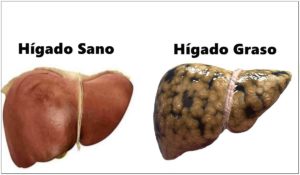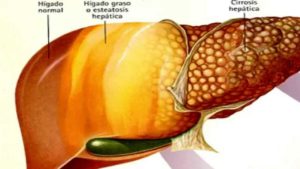Of every 10 patients, 8 suffer from fatty liver, also called hepatic steatosis, pathology diagnosed incidentally by abdominal ultrasound, a finding that some doctors have attributed little importance to consider that it does not represent any threat to the health and life of the patient evaluated, argued It is due to a simple alteration of fat metabolism, so its management is limited to reducing the consumption of fatty foods.

The skin is the largest blackboard where the liver and other internal organs write their sorrows and sorrows, on the skin we can detect with the naked eye some typical signs that indicate excessive accumulation of fat in the liver, among which we can mention: The Nevus Ruby (Fig. 2), it is a lunar type lesion or red warts (Blood Lunar), very common to find them during the physical exam, usually they appear on the skin of the neck, chest, shoulders and abdomen, so when noticed, the patient specifically relates it to an aesthetic problem, an impression that erroneously obliges him to consult a Specialist in Dermatology or Aesthetics; who frequently propose as the only solution, cauterization of injuries;

Excessively oily skin on the face, Seborrhea in the scalp and Detachment of the nails, which very often confuse with Onychomycosis (Nail fungus).
Complications of the Fatty Liver This course is full of errors due to ignorance, both from the health professionals who address these cases, as well as from the patient, leading to the disease prolonging indefinitely over time, seriously affecting the functioning of the liver, with the subsequent appearance of a NON-ALCOHOLIC ESTEATOHEPATITIS (Inflammation of the hepatocyte * due to the accumulated fat), and that if this complication is not timely intervened, it can lead to a fearsome NON-ALCOHOLIC HEPATIC CIRRHOSIS, due to severe liver tissue damage and depending on the severity of the disease some patients must undergo liver transplantation and in the worst case, this liver disorder as such; could lead inevitably to a HEPATOCARCINOMA (Liver Cancer), this pathology is extremely deadly. In Fig. 3, We can observe very simply, the way in which a normal liver affected by fat accumulation evolves, towards Hepatic Cirrhosis.

Causes of Fatty Liver
- Obesity
- Hyperlipidemia (High cholesterol and triglyceride levels)
- Organic toxicity
- Hypertension
- Nutrition Habits
- Prediabetes
- Bowel disease
- Rapid weight loss
- Heritage
- Some medications
It should be noted that the fatty liver can also be suffered by some patients who do not have any of the aforementioned triggers.
Diagnosis
The diagnosis can be clinical, taking into account the aforementioned risk factors and typical signs on the skin, as well as by ultrasound.
Treatment
From the approach of Integrative Gastroenterology, the successful treatment of fatty liver lasts between one and two years, depending on the time of evolution of the disease; Due to the high complexity of this organ, a treatment that is worthwhile in the end, taking into account that its evolution towards chronicity can lead to any of the serious complications already described.

